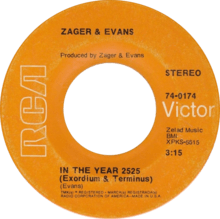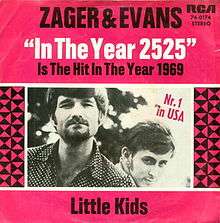In the Year 2525
"In the Year 2525" is a 1968 hit song by the American pop-rock duo of Zager and Evans. It reached number one on the Billboard Hot 100 for six weeks commencing July 12, 1969.[3] It peaked at number one in the UK Singles Chart for three weeks in August and September that year.[4] The song was written and composed by Rick Evans in 1964 and originally released on a small regional record label (Truth Records) in 1968.[5] It was later picked up by RCA. Zager and Evans disbanded in 1971.
| "In the Year 2525" | ||||
|---|---|---|---|---|
 RCA release | ||||
| Single by Zager and Evans | ||||
| from the album 2525 (Exordium & Terminus) | ||||
| B-side | "Little Kids" | |||
| Released | 1968 (Truth label) April 1969 (RCA label)[1] | |||
| Recorded | 1968, Odessa, Texas | |||
| Genre | Folk rock, psychedelic rock[2] | |||
| Length | 3:10 (Truth label) 3:15 (RCA label) | |||
| Label | Truth; RCA | |||
| Songwriter(s) | Rick Evans | |||
| Producer(s) | Zager and Evans | |||
| Zager and Evans singles chronology | ||||
| ||||
| Alternative release | ||||
 Artwork for the German vinyl single | ||||
Zager and Evans were one-hit wonders, recording artists who had a number one hit and then never had another chart single. They did this in both the U.S. Billboard Hot 100 and the UK Singles Chart and as of 2020, they are the only artists ever to have a chart-topping #1 hit on both sides of the Atlantic and never have another chart single in Billboard or in the UK for the rest of their career. Their follow-up single on RCA-Victor, "Mr. Turnkey", failed to enter the main music charts on either side of the Atlantic Ocean. Another single, "Listen to the People", managed to make the bottom slot of the Cashbox chart at number 100.
Summary
"In the Year 2525" opens with an introductory verse explaining that if mankind has survived to that point, he would witness the subsequent events in the song. Subsequent verses pick up the story at 1,010-year intervals from 3535 to 6565.[6] In each succeeding millennium, life becomes increasingly sedentary and automated: thoughts are pre-programmed into pills for people to consume, machines take over all work, resulting in eyes, teeth, and limbs losing their purposes, and marriage becomes obsolete since children are conceived in test tubes. Then the pattern as well as the music changes, going up a half step in the key of the song (chromatic modulation), after two stanzas, first from A-flat minor, to A minor.
For the final three millennia, now in B flat minor, the tone of the song turns apocalyptic: the year 7510 marks the date by which the Second Coming will have happened, and the Last Judgment occurs one millennium later. By 9595, with the song now in B minor, the Earth becomes completely depleted of resources, potentially resulting in the death of all life.
The song ends in the year 10,000. By that time, man has become extinct. But the song notes that in another solar system (or universe), the scenarios told in the song may still be playing out, as the beginning of the song repeats and the recording fades out.[6]
The overriding theme, of a world doomed by its passive acquiescence to and overdependence on its own overdone technologies, struck a resonant chord in millions of people around the world in the late 1960s.[7] The song was #1 on the Billboard Hot 100 singles chart during the Apollo 11 moon landing.
Recording
The song was recorded primarily in one take in 1968, at a studio in a cow pasture in Odessa, Texas.[8] Members of the Odessa Symphony also participated in the recording.
Personnel
- Denny Zager & Rick Evans – acoustic guitars & vocals
- Mark Dalton – bass guitar
- Dave Trupp – drums
- The Odessa Symphony – additional instruments
- Tommy Allsup – producer[9]
The record had regional success so RCA picked it up for a national release. Record producer Ethel Gabriel was tasked with enhancing the sound and arrangement. The track went to number 1 on the U.S. charts within three weeks of release.[10]
Legacy
The song has been covered at least 60 times in seven languages[11] and was included in a Clear Channel memorandum, distributed by Clear Channel Communications to every radio station owned by the company, which contained 165 songs considered to be "lyrically questionable" following the September 11, 2001, attacks.[12]
In a later Zager and Evans song, "Yeah 32" (1970), the group sing about writing a song called "In the Year 2525 or something like that/and if it sells, then I'll do well and pay this woman back". ("Yeah 32" was released as the B-side of "Help One Man Today", which like all of their post-"2525" releases failed to chart in the US or the UK.)
The song is parodied as "In the Year 252525" in the seventh episode of Futurama's sixth season, "The Late Philip J. Fry", as Fry, Professor Farnsworth and Bender travel forwards through time to find a period in which the backwards time machine has been invented.[13] A re-tooled version was used as the theme song for the TV series Cleopatra 2525, set aptly in the year 2525.
Chart history
Weekly charts
|
Year-end charts
All-time charts
|
See also
References
- "Zager And Evans - In The Year 2525 (Exordium And Terminus)". Retrieved March 23, 2020 – via www.45cat.com.
- "Zager & Evans - In The Year 2525". Discogs. Retrieved March 23, 2020.
- The Hot 100, Week of July 12, 1969 – Billboard.
- Roberts, David (2006). British Hit Singles & Albums (19th ed.). London: Guinness World Records Limited. p. 236. ISBN 1-904994-10-5.
- Miller, Nathaniel. "Hit song of 1969 recorded in Odessa". News OK. Retrieved 2016-10-02.
- Laffer, William D. (July 22, 1969). "'In the Year 2525' Began in the Year 1965: The Anatomy of a No. 1 Record". The Milwaukee Journal.
- Reynolds, Tom (2005). I Hate Myself and Want to Die: The 52 Most Depressing Songs You've Ever Heard. Milsons Point, N.S.W.: Random House. p. 85. ISBN 1-74166-020-3.
- "Drummer on only No. 1 hit to come out of Lincoln dies at 72 | Local". Journalstar.com. 2015-11-19. Retrieved 2016-10-02.
- Forte, Dan. "Tommy Allsup 1931-2017: From Buddy Holly to Bob Wills". VintageGuitar.com.
- "Zager and Evans | Way Back Attack". www.waybackattack.com. Retrieved 2019-11-21.
- "All versions of Some musics". Alltheversions.blogspot.com. Retrieved 2010-10-05.
- Wishnia, Steven (October 24, 2001). "Bad Transmission: Clear Channel's Hit List". Reviews. LiP magazine. Archived from the original on April 16, 2008. Retrieved January 18, 2011.
- "Futurama in the year 105105 time machine song". Vimeo. Retrieved March 23, 2020.
- Kent, David (1993). Australian Chart Book 1970–1992. St Ives, NSW: Australian Chart Book. ISBN 0-646-11917-6.
- Canadian peak RPM
- "Item Display - RPM - Library and Archives Canada". Collectionscanada.gc.ca. 1969-09-06. Retrieved 2019-03-17.
- "The Irish Charts – Search Results – In the Year 2525". Irish Singles Chart. Retrieved March 17, 2019.
- "Singoli – I numeri uno (1959–2006) (parte 3: 1980–1990)". It-charts.150m.com (in Italian). Archived from the original on 3 March 2016.
- "flavour of new zealand - search listener". www.flavourofnz.co.nz. Retrieved March 23, 2020.
- "Official Charts Company". Officialcharts.com. 1969-08-09. Retrieved 2019-03-08.
- "Zager & Evans – Awards". AllMusic. Archived from the original on 4 November 2013.
- Whitburn, Joel (1993). Top Adult Contemporary: 1961–1993. Record Research. p. 264.
- "Cash Box Top 100 8/09/69". tropicalglen.com. Retrieved March 23, 2020.
- "Go-Set Magazine Charts". www.poparchives.com.au. Barry McKay. January 2007. Retrieved 9 August 2017.
- "RPM Top Singles of 1969". Library and Archives Canada. RPM. Retrieved 24 December 2017.
- "Sixties City - Pop Music Charts - Every Week Of The Sixties". www.sixtiescity.net. Retrieved March 23, 2020.
- "Top 100 Hits of 1969/Top 100 Songs of 1969". www.musicoutfitters.com. Retrieved March 23, 2020.
- "Cash Box Year-End Charts: Top 100 Pop Singles, December 27, 1969". Archived from the original on January 25, 2019. Retrieved March 17, 2019.
- "Billboard Hot 100 60th Anniversary Interactive Chart". Billboard. Retrieved 10 December 2018.